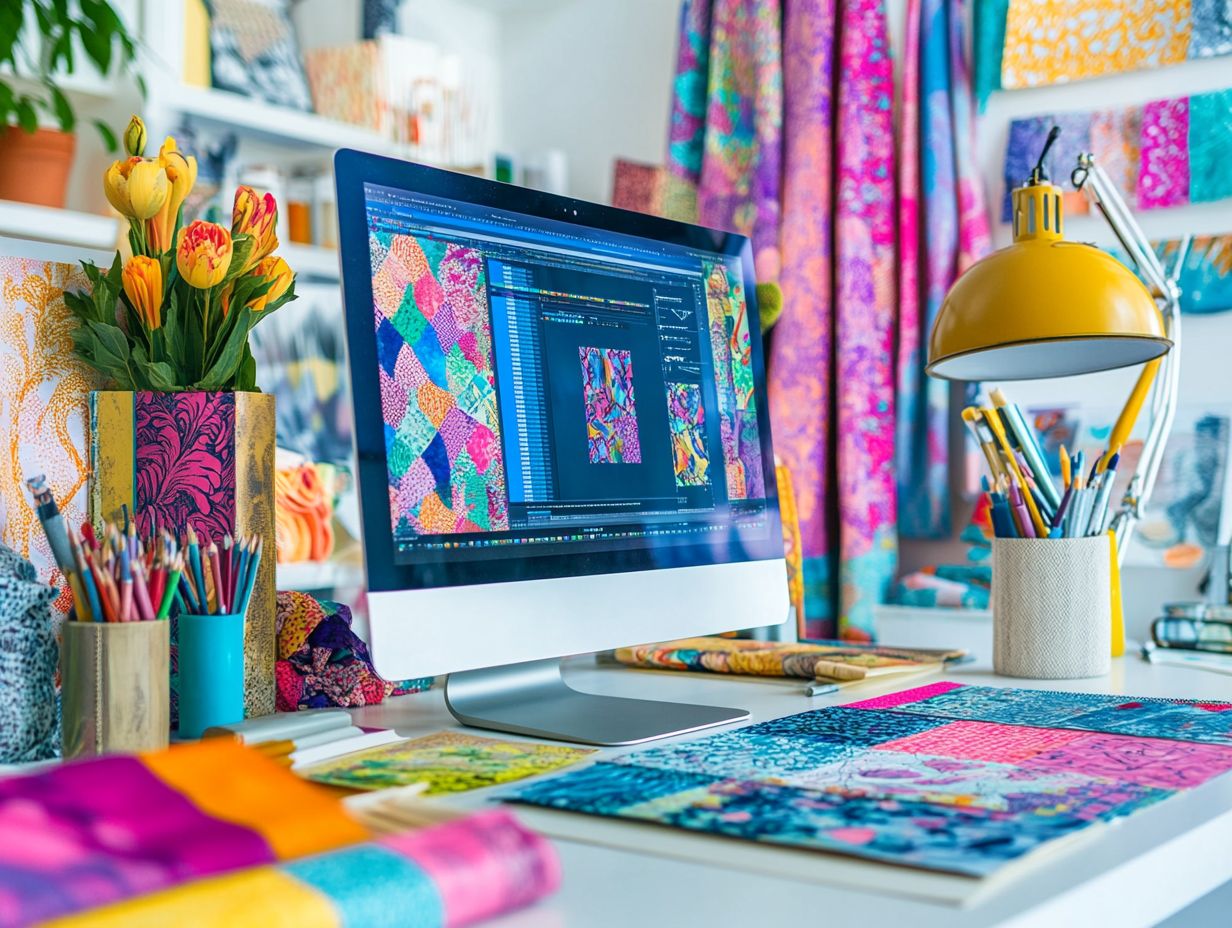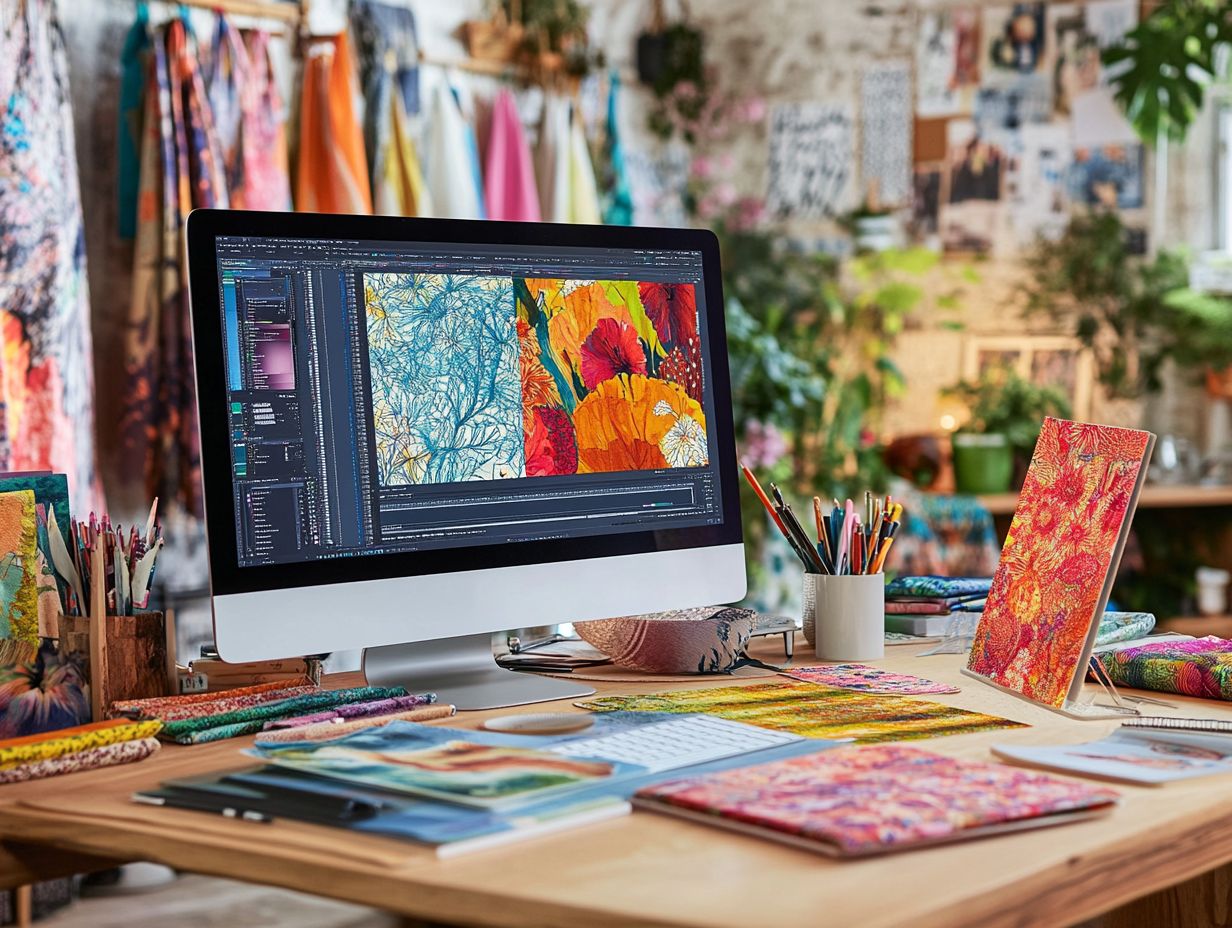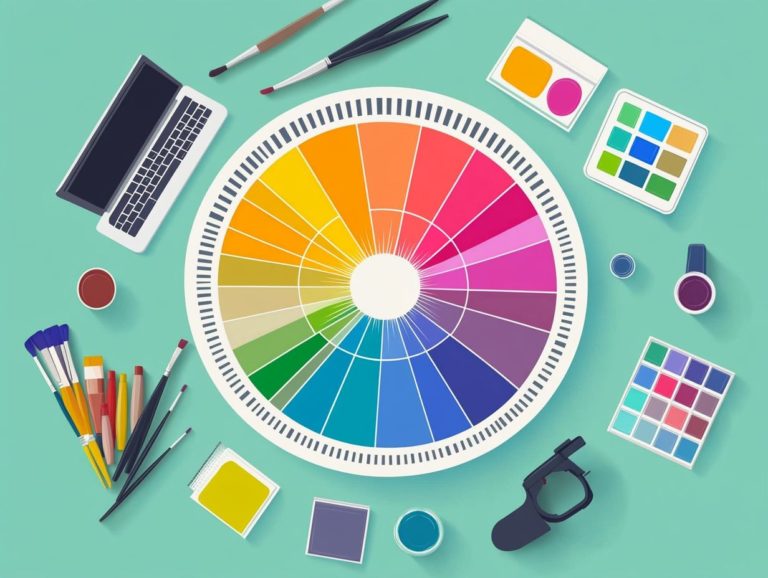Online Courses in Textile Design: What to Know
Textile design is a dynamic realm where creativity, technology, and functionality blend, making it an exhilarating option for aspiring designers like you.
As the demand for skilled textile professionals continues to rise, online courses have become a flexible avenue for you to acquire essential knowledge and skills.
Discover exciting online textile design courses that can kickstart your creative journey! This article outlines their benefits, potential challenges, and tips for selecting the ideal program for your needs.
Uncover job opportunities, essential skills, and strategies for crafting a standout portfolio as you navigate the ever-evolving landscape of textile design education.
Immerse yourself to discover how you can embark on this colorful journey!
Contents
- Key Takeaways:
- 1. What Is Textile Design?
- 2. Why Choose Online Courses for Textile Design?
- 3. What Are the Different Types of Online Courses Available?
- 4. How to Choose the Right Online Course for You?
- 5. What Are the Benefits of Taking Online Courses in Textile Design?
- 6. What Are the Challenges of Taking Online Courses in Textile Design?
- 7. What Skills Can You Expect to Learn in Online Textile Design Courses?
- 8. What Are the Job Opportunities for Textile Designers?
- 9. How Can Online Courses Help in Building a Portfolio?
- 10. What Are the Different Platforms for Online Textile Design Courses?
- 11. How Much Do Online Textile Design Courses Cost?
- 12. Are There Any Prerequisites for Taking Online Textile Design Courses?
- 13. What Are the Key Factors to Consider When Choosing an Online Textile Design Course?
- 14. How Can You Make the Most Out of an Online Textile Design Course?
- 15. What Are the Future Trends in Online Textile Design Education?
- Frequently Asked Questions
- 1. What are online courses in textile design?
- 2. What skills can I expect to learn in online courses in textile design?
- 3. What materials and equipment do I need for online courses in textile design?
- 4. How long do online courses in textile design typically take to complete?
- 5. Are there any prerequisites for enrolling in online courses in textile design?
- 6. What career opportunities are available after completing online courses in textile design?
Key Takeaways:

1. Textile design involves creating designs for fabrics using various techniques and materials.
2. Online courses for textile design offer flexibility, accessibility, and a diverse range of course options to students.
3. Types of online courses for textile design include certificate programs, degree programs, and individual courses.
1. What Is Textile Design?
Textile design is a captivating field where creativity intersects with technology. It allows you to develop innovative designs and patterns for various applications, from fashion to interior furnishings.
This field encompasses a diverse array of techniques and methodologies, including digital textile design which means designing patterns and images using computer software hand techniques, and traditional methods. This presents you with limitless creative possibilities.
The design brief acts as your roadmap, specifying objectives, target audiences, and materials. Meanwhile, color composition and digital print technologies are instrumental in transforming your ideas into stunning collections.
This discipline holds significant importance in the fashion industry, contributing not only to aesthetic appeal but also to functionality and innovation.
Importantly, the growing focus on sustainability encourages you to embrace eco-friendly practices, using organic materials and minimizing waste. This commitment elevates the importance of textile design and paves the way for a responsible fashion future.
2. Why Choose Online Courses for Textile Design?
Choosing online courses in textile design offers unmatched convenience and access to exceptional education from prestigious institutions like Central Saint Martins. This allows you, as an aspiring designer, to immerse yourself in digital textile design and various creative projects at your own pace through live online lessons and a virtual learning environment (VLE).
This mode of learning not only allows you to tailor your education to your personal schedule but also connects you with expert instructors who provide invaluable insights and guidance. You will actively participate in discussions and receive feedback from industry professionals, deepening your understanding of the craft.
The freedom to experiment with innovative design techniques in a collaborative online environment fosters your creativity and helps you build essential skills tailored specifically for digital textile work. This environment enhances your creativity and builds essential skills tailored for digital textile work, enabling you to improve your portfolio and prepare effectively for a competitive job market, all while enjoying the unique advantages of online education.
Start your journey in textile design today by exploring the best online courses available!
3. What Are the Different Types of Online Courses Available?
The realm of online education offers a rich assortment of courses crafted for aspiring textile designers. You can choose from foundational classes in Photoshop and Illustrator to specialized short courses that provide step-by-step exercises in digital textile design and garment manufacturing.
These resources accommodate various skill levels. As a beginner, you can build essential skills, while advanced learners can refine their expertise through comprehensive study. For instance, intermediate courses dive into fashion history and trend forecasting, equipping you with insights crucial for roles like fashion buyer or merchandiser.
Specialized programs focus on sustainability in textiles, equipping you with tools to meet the industry’s growing demand for eco-friendly solutions.
Whether your ambition lies in design, production, or marketing, this eclectic range of online options bridges the gap between passion and a thriving career in the dynamic fashion sector.
4. How to Choose the Right Online Course for You?
Selecting the right online course for textile design requires thoughtful consideration of your goals, desired skill level, and specific outcomes whether that’s crafting a digital portfolio or understanding project details while seeking personal feedback on your work.
It s vital to assess various factors, including the relevance and depth of the course content. Expect a blend of theoretical knowledge and practical applications that equip you for the field. The instructor s qualifications are equally important; an educator with a robust industry background offers invaluable insights.
Exploring student reviews and testimonials will give you a clearer picture of the course s effectiveness. By ensuring that the course objectives align with your aspirations and career goals, you set the stage for a fulfilling learning experience that enhances your skills and marketability in textile design.
5. What Are the Benefits of Taking Online Courses in Textile Design?

Taking online courses in textile design opens up numerous benefits. You develop vital skills in digital textile design, engage in creative projects, and focus on sustainable practices that contribute to waste reduction in the fashion industry.
These courses provide unparalleled flexibility, allowing you to learn at your own pace while juggling work, family, and other commitments.
Online platforms foster a strong sense of community. You can network with professionals and peers from diverse backgrounds, broadening your perspectives and opportunities. Your skill acquisition is enhanced through varied resources and real-time feedback from instructors.
With the industry’s growing focus on sustainability, learning eco-friendly practices is essential for any future textile designer. Enrolling in these online courses is a savvy choice for anyone looking to make a meaningful impact.
Join today and elevate your textile design skills!
6. What Are the Challenges of Taking Online Courses in Textile Design?
While online courses in textile design offer many advantages, they also come with challenges. You may grapple with the need for self-discipline, navigate potential technology hiccups, and face limitations in receiving timely feedback on assignments, especially in a field that thrives on hands-on experience.
Balancing coursework with other commitments can feel overwhelming, leading to procrastination. The absence of direct interaction with instructors and peers can make the learning experience isolating, which may dampen motivation.
To tackle these challenges, establish a structured schedule that suits your rhythm. Don t underestimate the power of virtual study groups to cultivate community.
Engaging with online forums or platforms designed for real-time feedback can significantly enhance your learning experience, paving the way for interactive discussions and quicker responses to your design inquiries.
7. What Skills Can You Expect to Learn in Online Textile Design Courses?
Online textile design courses equip you with essential skills. You ll master digital design software, create well-matched color palettes, and gain hands-on experience through creative projects.
By becoming proficient in industry-standard programs like Adobe Illustrator and Photoshop, you can effectively bring your artistic visions to life in digital formats. This expertise allows you to create intricate patterns and prepares you for real-world challenges, such as collaborating with fashion brands or producing samples for textile manufacturers.
Understanding color theory helps you make informed choices while designing collections, ensuring that your textiles look good together. Practical design techniques, honed through assignments and projects, prepare you to tackle challenges in the textile industry, whether it’s creating sustainable fabric designs or adapting existing patterns to align with market trends.
8. What Are the Job Opportunities for Textile Designers?
Get ready to explore a vibrant job market full of exciting opportunities for textile designers! The job market is expansive, spanning both the fashion industry and creative roles in garment manufacturing, textile decoration, and sustainable practices.
In this dynamic environment, you may find yourself stepping into roles such as product developer, textile researcher, or trend forecaster. Each of these requires a solid blend of technical expertise and creative flair. A deep understanding of materials, color theory, and textile construction is essential, especially as sustainability and slow fashion increasingly shape consumer preferences.
Online courses tailored to these disciplines provide you with the tools and knowledge to navigate emerging trends, focusing on eco-friendly practices and innovative design solutions. By refining these skills, you can establish yourself as a valuable asset in a field that prioritizes ethical production and creative sustainability.
9. How Can Online Courses Help in Building a Portfolio?
Online courses are invaluable in helping you, as an aspiring textile designer, build a strong digital portfolio. They provide structured creative projects that showcase your unique skills and talents while offering opportunities for personal feedback from industry experts.
These courses encourage project-based learning, enhancing your craftsmanship and fostering innovative thinking and problem-solving abilities. By tackling real-world projects, you can create pieces that reflect your individual style an essential element of a compelling portfolio.
In terms of building that portfolio, it’s crucial to include a diverse range of works that highlight your versatility. Consider incorporating:
- Mood boards
- Fabric samples
- Finished pieces
To present your portfolio effectively, focus on using high-quality images, concise descriptions, and a coherent layout that tells the story of your journey and growth as a designer over time. Start building your stunning portfolio today and showcase your talent to the world!
10. What Are the Different Platforms for Online Textile Design Courses?

Numerous platforms present you with a wealth of online textile design courses, offering various formats like live online lessons, pre-recorded sessions, and interactive virtual learning environments (VLE) tailored to your unique learning preferences and styles.
These courses enable you to delve into a myriad of techniques, ranging from digital printing to weaving and surface design. Some platforms emphasize hands-on projects and peer collaborations, cultivating a vibrant sense of community among learners.
Others may prioritize theoretical knowledge, delivering comprehensive lectures that explore the industry s history and current trends. The integration of interactive elements think quizzes, discussion forums, and real-time feedback greatly enriches your learning journey. Many users find these features solidify their understanding and keep their motivation soaring throughout the course.
11. How Much Do Online Textile Design Courses Cost?
The cost of online textile design courses can vary widely, influenced by factors like course length, the institution’s reputation, and content depth. View financial planning as an investment in your education and future career prospects.
Options range from free introductory classes to premium programs that can cost several thousand dollars. Weigh your choices carefully. Some institutions offer comprehensive curricula at higher prices, while many reputable platforms provide free resources to help you get started.
Create a budget that aligns with your financial situation and career aspirations. Explore scholarships, discounts, or installment payment plans to make premium courses more accessible. Reading reviews and comparing lesson plans will help you identify the best value for your investment.
12. Are There Any Prerequisites for Taking Online Textile Design Courses?
Many online textile design courses have prerequisites. These may include a foundational understanding of design principles, familiarity with software like Photoshop and Illustrator, or prior experience in creative projects involving digital textile design.
Before diving into formal education, aspiring designers should acquire these essential skills. Familiarizing yourself with color theory and different fabric types provides valuable context.
Utilizing free online resources or tutorials can enhance your confidence in using design software. Engaging in simple hands-on projects can significantly benefit your creative portfolio.
Adopting a proactive approach to skill-building will make you more competitive in course applications and enrich your overall learning experience.
13. What Are the Key Factors to Consider When Choosing an Online Textile Design Course?
When looking for an online textile design course, weigh key factors like course content, instructor qualifications, and student support levels. This will ensure an enriching educational experience that aligns with your personal goals.
Evaluate course structure by paying close attention to module format and duration. These elements can significantly influence your learning pace and comprehension.
Understanding specific learning outcomes is equally important. These deliverables shape your skills and knowledge in the textile design arena. Don t overlook opportunities for community engagement through forums, group projects, or collaborations with industry professionals.
These connections can enrich your learning experience, helping you network and gain practical insights beyond mere theoretical knowledge.
14. How Can You Make the Most Out of an Online Textile Design Course?
To elevate your experience in an online textile design course, immerse yourself in course materials, engage thoughtfully in discussions, collaborate actively with peers, and seek personalized feedback to refine your skills.
Set specific goals for each module to maintain your motivation and focus.
Actively participating in forums and sharing your insights can lead to meaningful collaborations, allowing you to draw from diverse perspectives. Utilizing discussion boards or group projects fosters community, making learning both enjoyable and effective.
By frequently seeking and applying feedback from instructors, you can make targeted improvements that sharpen your skills and enhance your work. This proactive approach ensures you absorb information and apply it creatively in the textile design landscape.
15. What Are the Future Trends in Online Textile Design Education?

The future of online textile design education is poised to be influenced by several key trends. You can expect to see the integration of advanced digital printing methods that use computers to create designs, a heightened focus on sustainability, and the increasing significance of collaborative online learning environments that encourage innovation and creativity.
As educators harness these technological advancements, you will gain access to cutting-edge software and tools that will enhance your design skills. The shift towards sustainable materials and ethical production methods will lead to curriculum updates that emphasize eco-friendly practices, aligning with industry demands and enabling you to make responsible choices.
Emerging pedagogical approaches, such as project-based learning and peer-to-peer feedback, will create a more engaging and interactive educational experience for you. These trends are set to transform the world of textile design, nurturing skilled designers ready to make a difference!
Frequently Asked Questions
1. What are online courses in textile design?
Online courses in textile design are virtual programs that teach students the fundamentals and techniques of designing and creating various textiles, such as fabrics, clothing, and home decor items. These courses are typically offered by universities, colleges, and online learning platforms, and can be completed entirely online.
2. What skills can I expect to learn in online courses in textile design?
Students can expect to learn a variety of skills in online courses in textile design. This includes color theory, pattern design, fabric manipulation techniques, and the use of design software. They will also develop their creativity, problem-solving, and critical thinking skills, while gaining knowledge about the history and cultural significance of textiles.
3. What materials and equipment do I need for online courses in textile design?
The required materials and equipment for online courses in textile design can vary depending on the specific course. Generally, students need a computer or laptop with internet access, design software such as Adobe Photoshop or Illustrator, basic art supplies like pencils and markers, and access to a sewing machine. Some courses may also require specific fabrics, yarns, or other materials for projects.
4. How long do online courses in textile design typically take to complete?
The length of online courses in textile design can vary. They usually take anywhere from a few weeks to a few months to complete. Some courses may have a set schedule with specific start and end dates, while others may be self-paced, allowing students to complete the course at their own pace within a certain timeframe.
5. Are there any prerequisites for enrolling in online courses in textile design?
Prerequisites for online courses in textile design can vary depending on the course and institution. Some courses have no prerequisites and are open to anyone interested in learning about textile design, while others may require students to have basic knowledge or experience in design or sewing. Check with the course provider for specific requirements.
6. What career opportunities are available after completing online courses in textile design?
Completing online courses in textile design can open up a variety of career opportunities. These include becoming a textile designer, fashion designer, interior designer, or textile artist. Graduates may also find work in industries such as fashion, home decor, or product design. Additionally, these courses can benefit individuals looking to start their own textile design business or enhance their skills for personal projects or hobbies.






